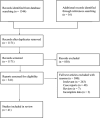Prevalence and clinical aspects of os trigonum: a meta-analysis
- PMID: 39586987
- PMCID: PMC12043738
- DOI: 10.1007/s12565-024-00811-4
Prevalence and clinical aspects of os trigonum: a meta-analysis
Abstract
Os trigonum (OT) is one of the most common accessory ossicles in the foot and ankle region. It is believed that OT was first described by Rosenmuller in 1804, but von Bardeleben is the one who coined the nomenclature for this anatomical variation in 1883. The literature indicates that OT is extremely variable in prevalence, with reported rates ranging from 1.7% to 32.5%. In clinical practice, OT is a considerable factor that may predispose patients to posterior ankle impingement syndrome (PAIS). The aim of this study was to provide comprehensive data on the prevalence and anatomical characteristics of OT. We conducted a comprehensive search of the main electronic databases to find the relevant research. Information concerning geographical origin, prevalence, gender distribution, imaging modality, and morphometry of OT was extracted. The PRISMA guidelines were strictly followed throughout the study. The reliability of the included studies was assessed using the AQUA tool. A total of 41 studies (n = 36,612 feet) were included in this meta-analysis. This meta-analysis showed that OT was present in 9.0% (95% CI: 7.4-10.8) of the feet, and was present bilaterally in 32.7% (95% CI: 23.3-43.7) of cases. Regarding the types of imaging modality used in the evaluation of OT by the included studies, prevalence assessed by X-rays was 8.2% (95% CI: 6.8-9.9), MRI was 24.2% (95% CI: 14.6-37.3), CT was 21.0% (95% CI: 12.8-32.5), and cadaveric dissection was 5.0% (95% CI: 3.4-7.4). OT was most commonly found in East Asia (11.0%, 95% CI: 7.1-16.8). Two studies provided enough data to calculate the odds ratio linking PAIS with OT. The analysis showed that patients with PAIS are almost 16 times more likely to have OT compared to those without PAIS (OR = 15.98, 95% CI = 0.255-1002.8). OT is a very common accessory ossicle and is present in nearly one in 10 feet. The highest prevalence is noted in the East Asian population. MRI and CT show the highest prevalence of OT. It is important to keep in mind the possible presence of OT when a patient is diagnosed with PAIS.
Keywords: Accessory ossicle; Anatomy; Foot and ankle anatomical variation; Os trigonum; Posterior ankle impingement syndrome.
© 2024. The Author(s).
Conflict of interest statement
Declarations. Competing interests: The authors have no relevant financial or non-financial interests to disclose. Ethics approval: Not applicable for this type of study (systematic review with meta-analysis).
Figures
Similar articles
-
Clinical aspects and epidemiology of os peroneum: a meta-analysis.Anat Sci Int. 2025 Apr 27. doi: 10.1007/s12565-025-00838-1. Online ahead of print. Anat Sci Int. 2025. PMID: 40289243
-
Evaluation of the Prevalence of Os Trigonum and Talus Osteochondral Lesions in Ankle Magnetic Resonance Imaging of Patients With Ankle Impingement Syndrome.J Foot Ankle Surg. 2019 Mar;58(2):273-277. doi: 10.1053/j.jfas.2018.08.043. Epub 2019 Jan 4. J Foot Ankle Surg. 2019. PMID: 30612863
-
Os trigonum: a discussion of its role in posterior ankle impingement syndrome and a meta-analysis of its prevalence.Surg Radiol Anat. 2024 Jul;46(7):1137-1143. doi: 10.1007/s00276-024-03389-8. Epub 2024 May 23. Surg Radiol Anat. 2024. PMID: 38780789 Review.
-
Posterior ankle impingement syndrome and os trigonum relationship in children.North Clin Istanb. 2022 Feb 8;9(1):23-29. doi: 10.14744/nci.2021.22587. eCollection 2022. North Clin Istanb. 2022. PMID: 35340317 Free PMC article.
-
The prevalence and anatomy of accessory navicular bone: a meta-analysis.Surg Radiol Anat. 2024 Oct;46(10):1731-1743. doi: 10.1007/s00276-024-03459-x. Epub 2024 Aug 13. Surg Radiol Anat. 2024. PMID: 39136746 Free PMC article.
Cited by
-
Computed Tomography Assessment of Os Trigonum in the Omani Population and Its Clinical Relevance.Diagnostics (Basel). 2025 Feb 5;15(3):373. doi: 10.3390/diagnostics15030373. Diagnostics (Basel). 2025. PMID: 39941303 Free PMC article.
-
Clinical aspects and epidemiology of os peroneum: a meta-analysis.Anat Sci Int. 2025 Apr 27. doi: 10.1007/s12565-025-00838-1. Online ahead of print. Anat Sci Int. 2025. PMID: 40289243
References
-
- Borenstein M, Hedges L, Higgins J, Rothstein H. 2022. Comprehensive Meta-Analysis Version 4. Biostat, Englewood, NJ 2022
-
- Burman MS (1931) The functional disturbances caused bythe inconstant bones and sesamoids of the foot. Arch Surg 22(6):936. 10.1001/archsurg.1931.01160060064004
Publication types
MeSH terms
LinkOut - more resources
Full Text Sources





